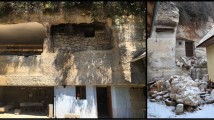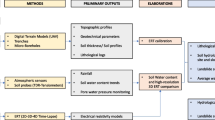Abstract
The deformation and failure of a loess slope are closely related to the loess collapsibility and permeability, which are primarily controlled by the pore geometrical structure. This is a microstructural investigation of loess and paleosol from Jingyang on the South Loess Plateau in China using X-ray micro-computed tomography to explore the three-dimensional pore structure by quantitative pore network parameters. The three soil types (L1, L2 and S2) exhibit complex pore structures and obvious anisotropy, as reflected by dense networks, wide pore size ranges and different pore throat radii and frequencies at different dip angles. From L1 to L2 to S2, the structure tends to become more compact, the pore size tends to decrease, and the connectivity tends to weaken; these differences chiefly depend on the particle composition. In soil with low clay content, the clay particles mainly act as connectors of silt and sand particles or adhere to their peripheries. With high clay content, the clay particles also combine with silt particles to form bulky aggregates, generating some large inter-aggregate pores and numerous fine intra-aggregate pores. Pore structure, which provides space for water movement, has a profound influence on the mechanical behavior of soil, and the relationship between permeability and pore structure is discussed. The results demonstrate the positive role that the pore (> 13 μm) proportion, pore connectivity and pore throat radius play in permeability. Both the pore throat radius and the permeability coefficient are greater in the vertical direction than in the horizontal direction, implying a large pore throat has a greater effect on water migration than that of multiple small pore throats.














Similar content being viewed by others
References
Assallay AM, Rogers CDF, Smalley IJ (1997) Formation and collapse of metastable particle packings and open structures in loess deposits. Eng Geol 48(1–2):101–115. https://doi.org/10.1016/S0013-7952(97)81916-3
Deng J, Wang LM, Zhang ZZ, Bing H (2010) Microstructure characteristics and forming environment of late quaternary period loess in the Loess Plateau of China. Environ Earth Sci 59(8):1807–1817. https://doi.org/10.1007/s12665-009-0162-x
Deng LS, Fan W, Peng XL, Xiong W (2013) Study on the effect of loess strength induced by different action methods of stochastic seismic load. Appl Mech Mater 310:185–189. https://doi.org/10.4028/www.scientific.net/AMM.310.185
Duan Z, Peng JB, Leng YQ (2016) Physico-mechanical characteristics of Q2 loess in South Plateau of Jingyang. J Chang’an Univ 36(5):60–109 (in Chinese)
Fan W, Deng LS, Yuan WN (2017) Double parameter binary-medium model of fissured loess. Eng Geol 31(11):1752–1756. https://doi.org/10.1016/j.enggeo.2017.09.014
Farahani E, Emami H, Keller T, Fotovat A, Khorassani R (2018) Impact of monovalent cations on soil structure. Part I. Results of an Iranian soil. Int Agrophys 32:57–67. https://doi.org/10.1515/intag-2016-0091
Gao GY (1988) Formation and development of the structure of collapsing loess in China. Eng Geol 25(2):235–245. https://doi.org/10.1016/0013-7952(88)90029-4
Gao YY, Qian H, Li XY, Chen J, Jia H (2018) Effects of lime treatment on the hydraulic conductivity and microstructure of loess. Environ Earth Sci 77:529. https://doi.org/10.1007/s12665-018-7715-9
Jiang MJ, Zhang FG, Hu H, Cui YJ, Peng JB (2014) Structural characterization of natural loess and remolded loess under triaxial tests. Eng Geol 181:249–260. https://doi.org/10.1016/j.enggeo.2014.07.021
Kie TT (1988) Fundamental properties of loess from Northwestern China. Eng Geol 25(2–4):103–122. https://doi.org/10.1016/0013-7952(88)90022-1
Lange DA, Jennings HM, Shah SP (1994) Image-analysis techniques for characterization of pore structure of cement-based materials. Cem Concr Res 24:841–853. https://doi.org/10.1016/0008-8846(94)90004-3
Lawrence GP (1977) Measurement of pore sizes in fine-textures soils: a review of existing techniques. Eur J Soil Sci 28(4):527–540. https://doi.org/10.1111/j.1365-2389.1977.tb02261.x
Lei XY (1985) Characteristics of loess pore distribution in north Shaanxi and east Gansu. Chin Sci Bull 30(5):656 (in Chinese)
Li YF (1991) Relationship between the permeability and the porosity of luochuan’s loess layer. J Xi’an Coll Geol 13(2):60–64 (in Chinese)
Li XA, Li LC (2017) Quantification of the pore structures of Malan loess and the effects on loess permeability and environmental significance, Shaanxi Province, China: an experimental study. Environ Earth Sci 76(15):523. https://doi.org/10.1007/s12665-017-6855-7
Li TC, Shao MA, Jia YH (2016) Application of X-ray tomography to quantify macropore characteristics of loess soil under two perennial plants. Eur J Soil Sci 67(3):266–275. https://doi.org/10.1111/ejss.12330
Li YR, He SD, Deng XH, Xu YC (2018) Characterization of macropore structure of Malan loess in NW China based on 3D pipe models constructed by using computed tomography technology. J Asian Earth Sci 154:271–279. https://doi.org/10.1016/j.jseaes.2017.12.028
Li P, Xie WL, Pak RYS, Vanapali SK (2019) Microstructural evolution of loess soils from the Loess Plateau of China. CATENA 173:276–288. https://doi.org/10.1016/j.catena.2018.10.006
Liang Y, Xl X, LI TL, Xu P, Liu SL (2012) Study of the anisotropic permeability and mechanism of Q3 loess. Rock Soil Mech 33(5):1313–1318 (in Chinese)
Lipiec J, Hajnos M, Świeboda R (2012) Estimating effects of compaction on pore size distribution of soil aggregates by mercury porosimeter. Geoderma 179–180:20–27. https://doi.org/10.1016/j.geoderma.2012.02.014
Ng CWW, Sadeghi H, Hossen SB, Chiu CF, Alonso EE (2016) Water retention and volumetric characteristics of intact and re-compacted loess. Can Geotech J 53(8):1258–1269. https://doi.org/10.1139/cgj-2015-0364
Nimmo JR (2004) Porosity and pore size distribution. Encycl Soils Environ 3:295–303. https://doi.org/10.1016/B978-0-12-409548-9.05265-9
Pagliai M, Vignozzi N, Pellegrini S (2004) Soil structure and the effect of management practices. Soil Till Res 79(2):131–143. https://doi.org/10.1016/j.still.2004.07.002
Peng JB, Tong X, Wang SK, Ma PH (2018) Three-dimensional geological structures and sliding factors and modes of loess landslides. Environ Earth Sci 77:675. https://doi.org/10.1007/s12665-018-7863-y
Rabbani A, Jamshidi S, Salehi S (2014) An automated simple algorithm for realistic pore network extraction from micro-tomography images. J Petrol Sci Eng 123:164–171. https://doi.org/10.1016/j.petrol.2014.08.020
Rendell HM (1988) Comparison between naturally consolidated and laboratory consolidated loess. Eng Geol 25(2):229–233. https://doi.org/10.1016/0013-7952(88)90028-2
Rezaee MR, Jafari A, Kazemzadeh E (2006) Relationships between permeability, porosity and pore throat size in carbonate rocks using regression analysis and neural networks. J Geophys Eng 3(4):370. https://doi.org/10.1088/1742-2132/3/4/008
Romero E, Simms PH (2008) Microstructure investigation in unsaturated soils: a review with special attention to contribution of mercury intrusion porosimetry and environmental scanning electron microscopy. Geotech Geol Eng 26(6):705–727. https://doi.org/10.1007/s10706-008-9204-5
Sakellariou A, Sawkins T, Senden T, Limaye A (2004) X-ray tomography for mesoscale physics applications. Phys A 339(1):152–158. https://doi.org/10.1016/j.physa.2004.03.055
Vogel HJ, Roth K (2001) Quantitative morphology and network representation of soil pore structure. Adv Water Resour 24(3):233–242. https://doi.org/10.1016/S0309-1708(00)00055-5
Wang M, Bai X, Frost D (2010) Influence of initial water content on the collapsibility of loess. Geoshanghai Int Conf. https://doi.org/10.1061/41103(376)9
Wang GL, Li TL, Xing XL, Zou Y (2015) Research on loess flow-slides induced by rainfall in July 2013 in Yan’an, NW China. Environ Earth Sci 73:7933. https://doi.org/10.1007/s12665-014-3951-9
Wei YN, Fan W, Cao YB (2017) Experimental study on the vertical deformation of aquifer soils under conditions of withdrawing and recharging of groundwater in Tongchuan region, China. Hydrogeol J 25:297–309. https://doi.org/10.1007/s10040-016-1498-4
Wen BP, Yan YJ (2014) Influence of structure on shear characteristics of the unsaturated loess in Lanzhou, China. Eng Geol 168:46–58. https://doi.org/10.1016/j.enggeo.2013.10.023
Yuan WN, Fan W, Jiang CC, Peng XL (2019) Experimental study on the shear behaviors of loess and paleosol based on ring shear tests. Eng Geol 250:11–20. https://doi.org/10.1016/j.enggeo.2019.01.007
Zhang ZH (1964) Study on microstructure of loess soil in China. Acta Geol Sin 44(3):113–131 (in Chinese)
Zhao B, Wang JF (2015) 3D quantitative shape analysis on form, roundness, and compactness with μCT. Powder Technol 291:262–275. https://doi.org/10.1016/j.powtec.2015.12.029
Zhu HZ (1963) Some Characteristics of the granules and structure of the Malan loss in the middle reaches of the Yellow River. Sci Geol Sin 4(2):88–100 (in Chinese)
Zong YT, Yu XL, Zhu MX, Lu SG (2015) Characterizing soil pore structure using nitrogen adsorption, mercury intrusion porosimetry, and synchrotron-radiation-based X-ray computed microtomography techniques. J Soil Sediment 15(2):302–312. https://doi.org/10.1007/s11368-014-0995-0
Acknowledgements
This work has been supported by the National Natural Science Foundation of China (Grant Nos. 41630634 and 41602281) and the Fundamental Research Funds for the Central Universities (Grant Nos. 310826173401 and 310826161019). In addition, the authors would like to thank the reviewers and the editors for their valuable comments, which improved the quality of this paper.
Author information
Authors and Affiliations
Corresponding author
Additional information
Publisher's Note
Springer Nature remains neutral with regard to jurisdictional claims in published maps and institutional affiliations.
Rights and permissions
About this article
Cite this article
Wei, T., Fan, W., Yuan, W. et al. Three-dimensional pore network characterization of loess and paleosol stratigraphy from South Jingyang Plateau, China. Environ Earth Sci 78, 333 (2019). https://doi.org/10.1007/s12665-019-8331-z
Received:
Accepted:
Published:
DOI: https://doi.org/10.1007/s12665-019-8331-z




